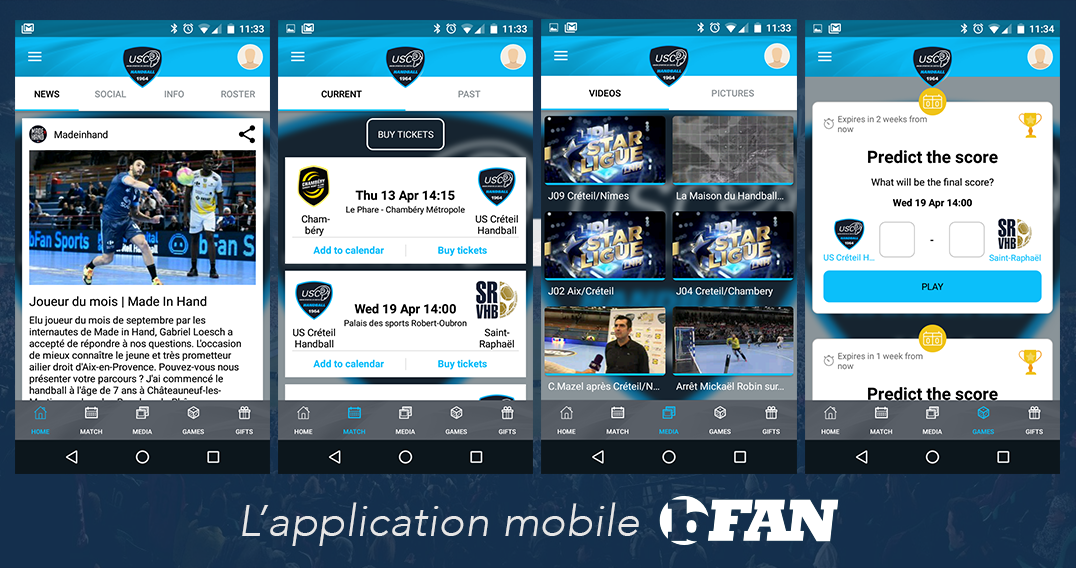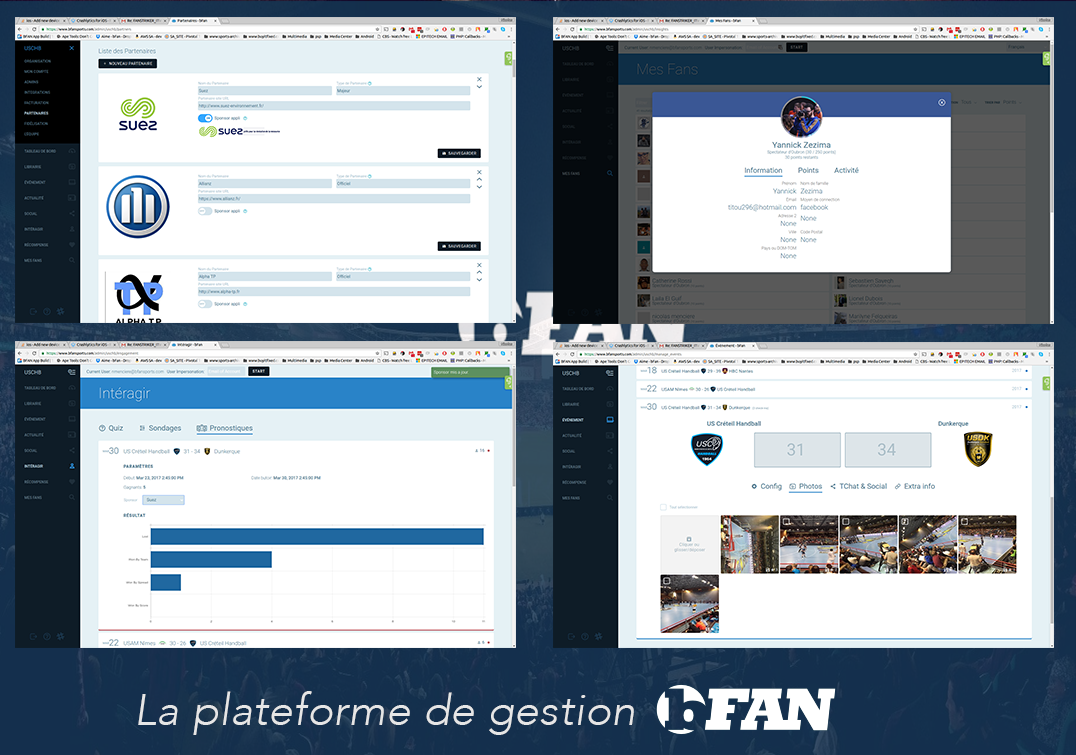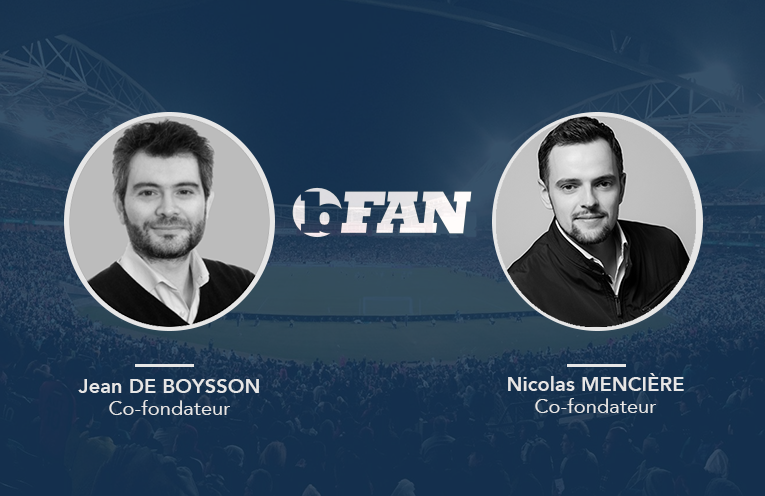Find out more about their concept.
Hi Nicolas, can you give us a brief introduction to bFAN? bFAN enables professional leagues and clubs to offer their fans unforgettable experiences.
More concretely, it’s a mobile application for the club, free of charge for fans, on which the club can post varied content thanks to our “fan engagement” platform, with the aim of transforming the experience of its fans.
This application offers clubs a new way of communicating, building fan loyalty and promoting their sponsors by offering new digital spaces. What exactly is the target for bFAN? We specifically target professional team clubs, where the notion of a fan community is particularly important, as well as one-off or recurring events requiring a mobile app.
We provide them with a turnkey app in true white label (editor’s note: the bFAN brand does not appear anywhere) in the club’s colors. If there was one big advantage for clubs to use bFAN, what would it be? bFAN offers many advantages for clubs, the first being that the club will have a professional mobile application similar to those of big clubs (PSG, Monaco) but at a fraction of the cost.
What’s more, the club automatically gets the latest features, updates and bug fixes.
A test application is delivered within a few days, and once the contract is signed, it’s available in a few weeks in the Google and Apple stores.
So there are no risks or surprises for clubs.
Then, thanks to the app, the club can involve its fans in matches, thanks to an innovative gamification and loyalty system.
It’s also a tool that enables the club to create “User Generated Content” (content generated by the fans themselves) and then reuse it on social networks.
Finally, and this is particularly important for clubs, their partners can be promoted within the app through various digital spaces.
So the app is no longer a cost, but a source of revenue for them.
A particularly interesting aspect for clubs with limited budgets.
 bFAN
bFANThe bFAN mobile application
How does bFAN benefit fans? With bFAN, the fan is the big winner.
They have the remote control of the match in their hands.
They’re in constant contact with the team.
They get live information, receive push notifications and participate in the decisions and life of the club.
For example, the club can ask fans to predict the score at half-time, or to take part in surveys.
And the more the fan is involved with the club, the more the club can directly recognize their loyalty by offering them unique experiences such as meeting players or winning unique gifts such as autographed team shirts. How did you come up with the idea of designing a mobile application to help clubs animate their fan community? With my partner Jean de Boysson, we started thinking about a concept in sports a few years ago.
Over time the idea evolved until 2014/2015 when we realized that very little was being done for fans.
So we decided to launch bFAN.
In contact with clubs, we realized that there was also a strong need among clubs to have their own mobile app to interact with their fans, but their budgets were limited.
This is what ultimately solidified our offer: a high-end but turnkey product accessible to all clubs. It’s a good idea, but how has the app been received by clubs? We’ve had very good feedback from the clubs we’ve presented bFAN to.
It’s practically 100% positive feedback.
The clubs have understood that there is a real need on the part of their fans to benefit from a digital solution like ours.
They also have modernization constraints imposed by their leagues, and a need to attract an ever-younger audience.
 bFAN
bFANThe management platform for the club, similar to the WordPress universe
On the other hand, the sales cycle in a club is a little long, which can be explained by the fact that the decision-makers are sometimes different and not easily accessible.
But there is real interest in a new way of distributing content and monetizing it by targeting the public.
It’s also a possible solution for increasing fill rates, the number of partners and matchday and non-matchday revenues. Like many projects in sport, I know that bFAN is a real team project.
Can you tell us more about the people behind the project? As I said earlier, we are two co-founders: myself(Nicolas Mencière) and Jean de Boysson.
We both have technical backgrounds in computer engineering.
Jean attended INSEAD and EPITA, a more business-oriented school, while I did EPITECH and a more technical Master’s degree in project management in the USA.
We met in New York, where we worked for the same company: Morgan Stanley, a major investment bank.
Today, we’re a team of 8, mainly in tech, but we’re also developing the commercial side.
 bFAN
bFANNicolas and Jean, the two co-founders of bFAN
On the financial side, did you receive any special support or assistance when you launched your start-up? No, none, because we’re still very young.
We haven’t taken part in anything yet, but we may soon. As for YPPA, it may still be early days, but have you won any particular awards or accolades for this project? Not yet, but we hope to soon 🙂 However, we were mentioned in SportTechie magazine in the USA last June.
The article can be read here. You’re currently at Le Tremplin, the number 1 sports startup incubator in Paris, but what are your short- and longer-term ambitions?
How do you see bFAN in 5 years’ time? Today, Le Tremplin provides us with exceptional support and a strong bond between startups in the sector.
In the long term, it’s very likely that we’ll move elsewhere, primarily for reasons of space.
In 5 years’ time, we’re aiming for a fairly rapid internationalization towards EMEA (Europe, Middle East, Africa), which will enable us to develop a global experience and become a leader in the fan experience. THE FAN EXPERIENCE IN GENERAL – A VIEWPOINT As a specialist, a player in the sports world and also a fan, what do you think of the spectator experience in today’s stadiums? For me, there’s a lot of progress to be made.
There’s a lot to build on, that’s for sure.
We certainly need to adapt on a case-by-case basis and make the best decisions.
“I think the fan’s current experience is better in front of their TV than when they’re at the stadium, and we want to change that. In France, the match remains the number 1 element. The event must not be focused solely on the opposition between the two teams. Spectators need entertainment. So we need to put on a show. We know that the population is aging, so we need a real strategy to attract younger people and adapt to them and their demands. The next turning point is recruiting the next generation.
Even if the American model is not necessarily adapted to the French model, there are best practices to follow and draw inspiration from.
In particular, before, during and after the match.
Make the match an event within an event, and get people to come 1 hour before kick-off and leave 1 hour afterwards.
All with the aim of enhancing the stadium experience and increasing revenues. In your opinion, are clubs doing enough to fill their stadiums and attract a wider audience? Clearly, I don’t think so.
In France, too much emphasis is placed on players and sporting results as the sole key to success and growth.
Clubs don’t focus enough on growing the fan base, preferring to invest in recruiting the best players and coaches.
They often don’t have a vision of the fan experience as a profit axis, but instead focus on short-term visibility.
Whereas the more fans there are, the more the club shines and earns revenue.
In my opinion, clubs need to make a real effort to put the fan back at the heart of the event, because he’s the key player in the club: he’s a member, he speaks out, conveys the image and makes it worthwhile to bring in partners.
Our application responds to two of these aspects: communication and the creation of strong links between the club and its fans, which increases the club’s notoriety. Every Friday, we feature a new fan experience idea in our #FridayIdea column.
Today, it’s your turn.
What ideas could you put forward to boost the spectator experience in sport? I’d like to make them more active and less passive, especially before, during and after a match.
Like what the bFAN app offers, or via an innovative concept like that of the Screaming Eagles, which we’ll be discovering in detail shortly in a major feature on Fanstriker (fans make the decisions, give their opinion, share ideas and live an enhanced experience).
Putting fans back at the heart of the show by giving them visibility, and offering them an unforgettable experience.
Fans complain about their lack of decision-making power, the latest Fan Story by Charlotte, an RC Lens fan says it all.
It might be a good idea to increase their decision-making power for their team.
Or in part for recruitment, for example. Finally, to conclude, we usually ask everyone we meet to give us an idea for the next interview with sports players?
What point of view would you like to hear on the subject of the fan experience? I’d like to hear from club community managers, who are really in touch with the fans.
I’d like to hear from people in several different sports.
How are they organized, are there differences between countries, or are there similar issues?
The second interesting area to study is club partners.
Why do they join a club, and what do they expect in return?
Would they like something extra?
You may already have been able to use this white-label application without knowing it at the Hand Star Game, or you’ll certainly be able to find it again soon in certain clubs. Thank you Nicolas for this interview with the sport’s key players.
If you’d like to keep up with bFAN news, this is the place to be: Twitter | Facebook | Website


